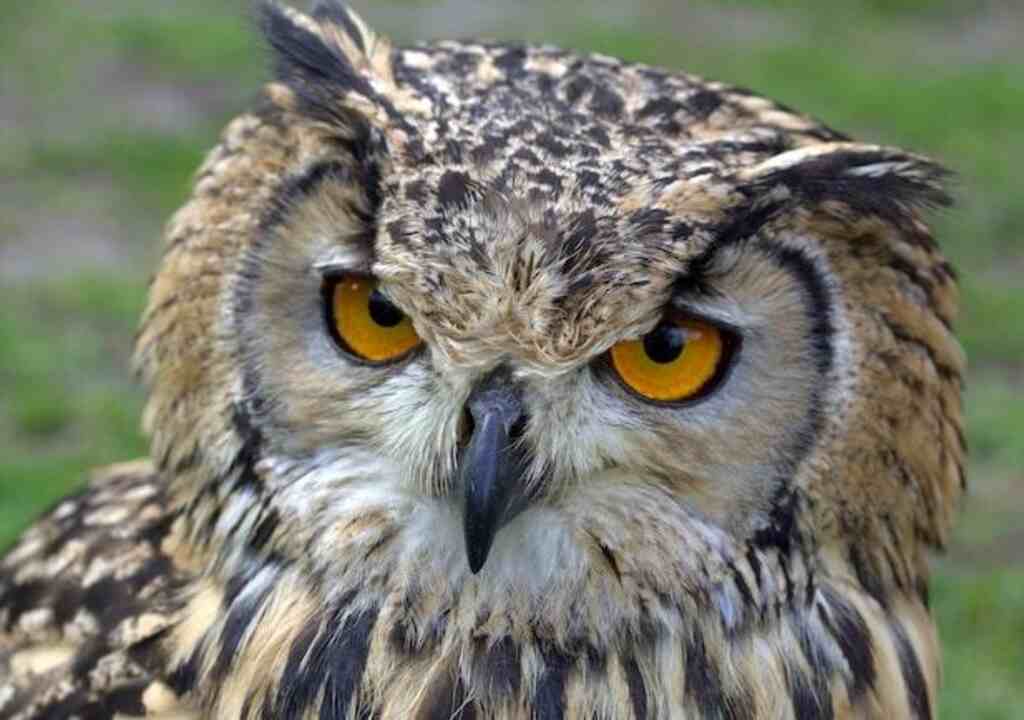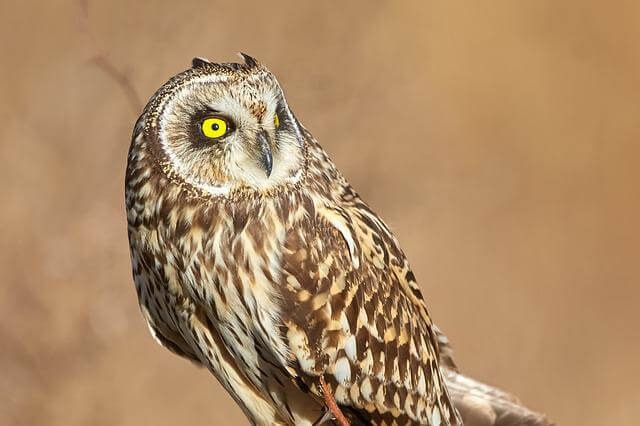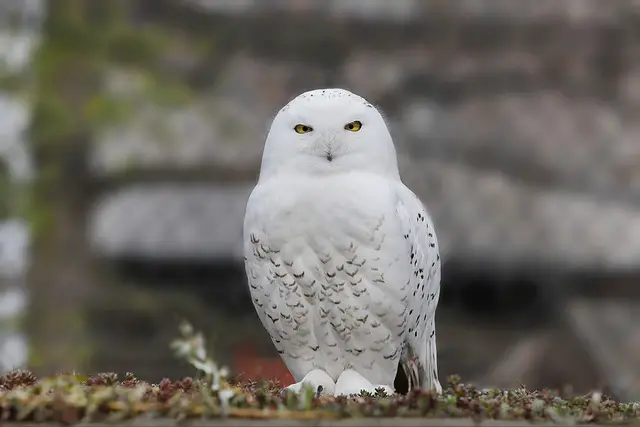Why Do Owls Have Such Large Eyes?” It’s not just for a dramatic look! These nocturnal creatures have evolved to rely on their oversized eyes to survive. Discover the fascinating reasons behind their huge eyesight and how they use it to their advantage in the dark. Get ready to be amazed!
Table of Contents
The Mystery of Owls’ Large Eyes: Understanding an Elusive Creature
Owls are some of the most incredible creatures in the animal kingdom. With their distinctive hooting call and sharp talons, these birds of prey are stealthy hunters that strike fear into the hearts of their prey.
However, there is one particular feature that sets owls apart from other birds: their strikingly large eyes. At first glance, it’s easy to be captivated by these enormous eyes – they almost seem human-like in size!
But why do owls have such large eyes? Are they just a unique characteristic that makes them stand out from other birds, or do they serve a specific purpose?
In this article, we’ll dive deep into the world of owls and explore their unique features, with a special focus on those giant eyes. Owls are known for their nocturnal habits – they’re active at night when most other animals are sleeping.
But how do these creatures navigate in low-light conditions? The answer lies in the size and structure of their eyes.
The pupils of an owl’s eye dilate to allow maximum light to enter. Additionally, the retina (the part responsible for detecting light) has more rod cells than cone cells, which allow them to see better in dim light condition.
But why do they need such excellent night vision? Hunting is mainly done during twilight periods; therefore, owls’ night vision allows them to hunt successfully even when it’s dark outside.
They can spot prey moving on the ground even under dense foliage or snow cover – thanks to those large eyeballs! In addition to excellent night vision capabilities, owls also have fascinating adaptations that make them highly efficient predators.
Their silent flight is one such adaptation – specialized feathers on their wings allow them to fly without making any noise while hunting. Such adaptations paired with large-sized eyes make them lethal hunters that inspire awe among bird watchers and naturalists alike.
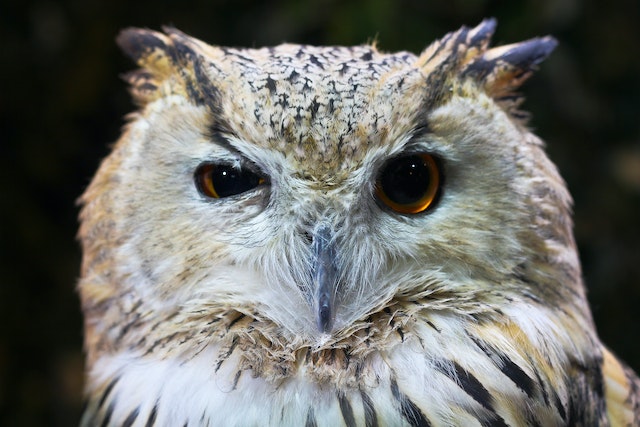
The Importance of Vision for Owls
Owls are known for their exceptional vision, which is essential for their survival. They rely heavily on their sight to hunt and locate prey, as well as navigate and avoid danger. Their eyesight is so powerful that they can see prey from a distance of up to 100 feet away in complete darkness.
This exceptional visual acuity is what makes owls such successful nocturnal hunters. Despite their remarkable vision, owls still face significant challenges in low-light environments.
In the dark, it can be extremely difficult to spot prey or even avoid obstacles, increasing the risk of injury or death. The eyes of most animals rely on the presence of light to function correctly.
However, owls have evolved unique adaptations that allow them to perceive and process visual information even in complete darkness.
One such adaptation is the arrangement of photoreceptor cells within an owl’s retina that enables them to perceive small changes in light contrast levels better than other animals.
Owls also have a high concentration of rod cells in their retina, which are more sensitive than cone cells and help them pick up faint light signals better than other animals do.
Given these unique adaptations, it’s no surprise that owls have some of the best night vision capabilities among all animals on earth!
Adaptations for Night Vision: Seeing in the Dark
Owls are known for their excellent night vision and ability to hunt in low-light environments. This is due to several adaptations in their eyes that allow them to see better than most other nocturnal animals. One of the main adaptations is the structure and function of their eyes, which differ greatly from human eyes.
The back of the eye houses the retina, which detects light and sends signals to the brain. In owl eyes, there are more rod cells than cone cells on their retina, which makes them more sensitive to light at low levels.
Additionally, owls have a large number of densely packed rod cells in an area called the fovea centralis, which allows for sharp visual acuity even in dim lighting conditions.
Compared to human eyes, owls’ eyes are much larger relative to their head size. This allows more light to enter their eye and reach the retina.
In fact, an owl’s eye is about 2-3 times larger than a human eye! This extra-large size helps with light gathering ability and enables them to see objects even when it’s almost completely dark outside.
Comparison with Human Eyes: A Different Approach
The way that owls’ eyes function differs greatly from humans as well. For example, while humans have a fixed lens that focuses incoming light onto the retina – allowing us to focus on objects at different distances – owls have a flexible lens that can change shape depending on where they’re focusing.
Owls can also rotate their heads up to 270 degrees without moving their bodies! They do this by having extra vertebrae in their necks that allow them greater mobility.
This flexibility enables them not only see what’s directly in front of them, but also look around without having to move as much.
In addition, another adaptation for night vision is the presence of a tapetum lucidum, a reflective layer behind the retina.
The function of this layer is to reflect light back through the retina, which results in an increased amount of detectable light. Humans don’t have this layer in their eyes, which is why we aren’t as good at seeing in low-light environments.
Larger Eyes and Night Vision
Owls’ large eyes are essential for their ability to see at night. As previously mentioned, larger eyes allow more light to enter and reach the retina. This ability to gather more light enables owls to spot prey from far away, even in complete darkness.
Moreover, owls’ pupils can dilate up to three times larger than human pupils, allowing even more light into their eyes.
This dilation happens quickly – within two seconds – making it possible for them to adjust quickly when they need to.
Owls have several adaptations that allow them excellent night vision and make them one of nature’s most impressive nocturnal hunters.
Their specialized eye structure and function – particularly larger size and numerous rod cells – help them gather more light and see better in low-light environments than most other animals.
Other Benefits of Large Eyes
The Wide View
Owls’ sizeable eyes offer a substantial advantage in terms of the range of vision they can experience. Owls have an excellent field of vision that allows them to view their surroundings from all angles and keep an eye out for any danger or prey.
This wide-angle view is due to the large size of their eyes and placement on the sides of their heads. It gives them a distinct advantage over predators with forward-facing eyes, such as humans or cats, that provide little peripheral vision.
In addition, the wide angle helps owls see potential threats more quickly, allowing them to take evasive action before it is too late. The ability to perceive movement from greater distances is also enhanced by this aspect.
Owls can detect small movements in their surroundings, which would otherwise go unnoticed by other animals with smaller eyes. Their large pupils allow for more light to reach the retina, enabling owls to better differentiate between contrasts and colors in low-light conditions.
Depth Perception: The Ability To Judge Distance
Another benefit that comes with having larger eyes is depth perception. This is because our brains use two slightly different images from each eye’s viewpoint to calculate how far away an object is from us – something we call “stereoscopic depth perception.”
Since owls have larger eyes than most birds and a wider visual field, they have improved stereoscopic vision that helps them determine how far away an object like prey or predators are located.
This ability also makes it easier for owls when flying at night while avoiding obstacles like trees or other obstructions because they can judge distances with great accuracy even when there’s little light available.

Evolutionary Factors
Overview on the evolution process that led to the development of large eyes in owls
Owls are fascinating creatures that have evolved over millions of years to become the apex predators of the night. One of their most distinctive features is their large eyes, which allow them to see in low-light conditions and hunt with maximum efficiency.
But how did these magnificent birds come to have such big eyes?
According to scientific research, owls’ large eyes are a result of millions of years of evolution. Fossil records suggest that ancient owl-like birds had small eyes similar to other bird species.
However, as they adapted to hunting at night, their eyes grew larger and gained more light-sensitive cells called rods, which help them see in dim light. The evolution process took place over a long period of time and happened gradually as owls encountered new challenges.
As they became better hunters at night, they needed larger eyes with more rods to catch prey more effectively. Over time, this adaptation became a genetic trait passed down through generations until all modern-day owls developed larger than average eyes.
Discussion on why this trait was beneficial for survival
Owls’ large eyes were highly beneficial for their survival because they allowed them to hunt efficiently at night when most other predators were inactive or unable to hunt effectively.
This gave owls a distinct advantage over their competitors and allowed them to thrive in different ecosystems around the world.
Apart from helping them see in low-light conditions, the large owl’s eye also provides a wider field of view compared to other bird species.
This means they can spot prey from farther away and have an increased awareness of potential threats or predators around them.
Overall, the evolutionary development of large owl’s eye is essential for owl’s survival as it enabled these nocturnal hunters with superior vision, making it possible for them not only to survive but also to thrive.
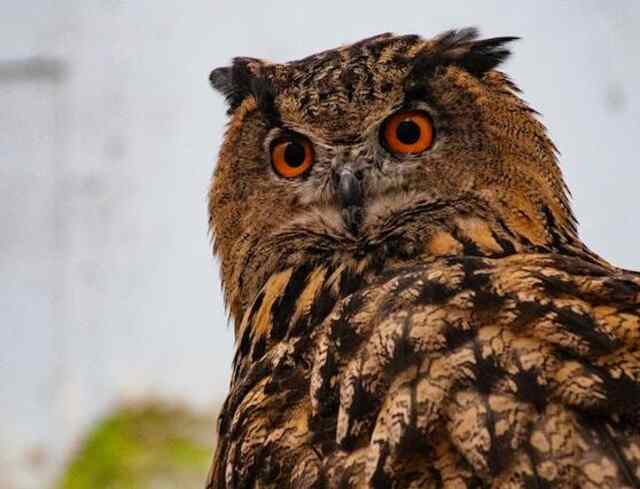
Conclusion
After exploring the various reasons why owls have such large eyes, it is clear that this unique trait is vital to their survival. Owls are primarily nocturnal, and as a result, they need to rely heavily on their vision to hunt and survive.
Their eyes have evolved over time to adapt to these conditions, allowing them to see in low-light environments and accurately locate prey. One of the key adaptations that help owls with their night vision is their specialized eye structure.
Unlike human eyes, which have a fixed lens shape and pupil size, owl eyes can adjust both of these factors to optimize light gathering ability. Additionally, the larger size of owl eyes helps them capture more light, giving them an advantage in locating prey.
Another significant benefit of large owl eyes is their wider field of view. Owls can rotate their heads up to 270 degrees due to unique bone structures in their necks.
This allows them an incredibly wide peripheral vision range, which can be crucial when searching for prey or avoiding predators. While there are many fascinating features about owls that make them stand out among other birds, none are quite as impressive as their large eyes.
These unique organs allow owls not only to survive but thrive in low light environments where others may struggle. Next time you catch a glimpse of an owl at night with its glowing big round eyes staring back at you – know that it has evolved over millions of years into the perfect nocturnal predator thanks in part due its iconic feature: its large luminous peepers!
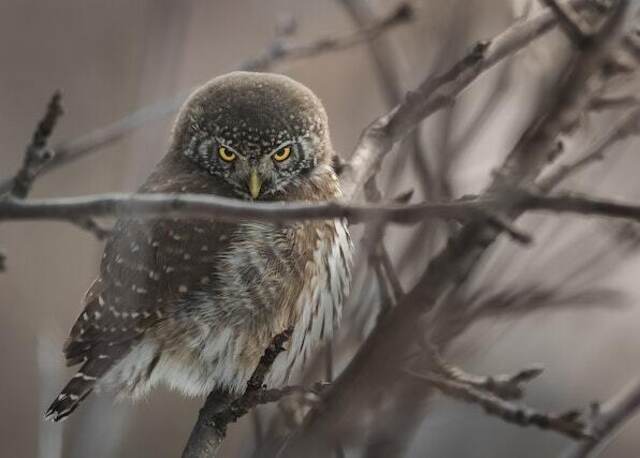
FAQs: Why Do Owls Have Such Large Eyes?
What is special about an owl’s eyes?
Owls have eyes that are larger than most other birds and are also fixed in their sockets, meaning they cannot move their eyes around like humans can. They are incredibly efficient at capturing light and have many adaptations that allow them to see in low light conditions, including an enlarged cornea, pupil, and retina.
Do owls have the biggest eyes?
In terms of eye size relative to their body size, yes, owls have some of the largest eyes of any bird. However, in absolute size, the eyes of some other birds, such as ostriches and emus, are larger.
Why do great horned owls have big eyes?
Great horned owls have big eyes because they are nocturnal predators that rely on their vision to locate prey in low light conditions. Their large eyes allow them to capture more light and see in the dark, giving them an advantage over their prey.
Why are owl’s eyes tubular?
Owls have tubular-shaped eyes that are elongated in the vertical direction. This shape allows them to see more clearly in low light conditions and gives them the ability to judge depth and distance accurately, important for hunting prey in the dark.

